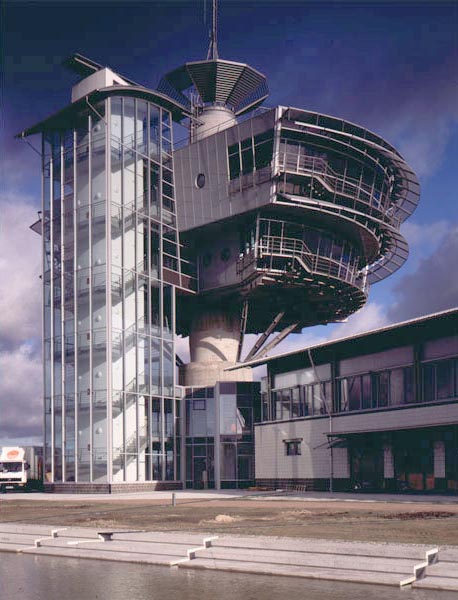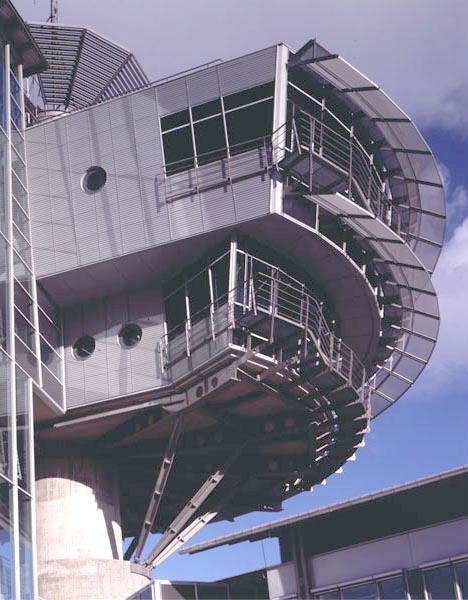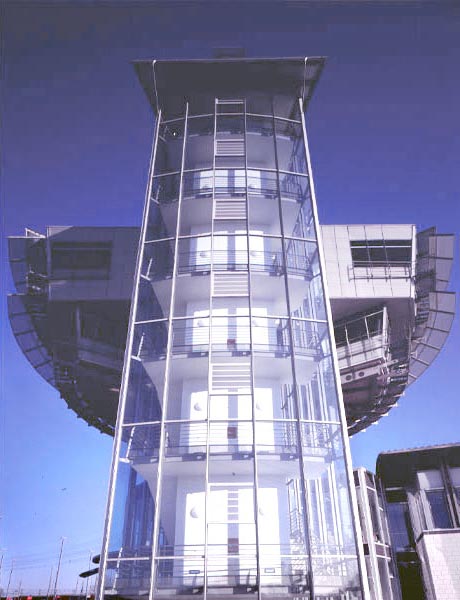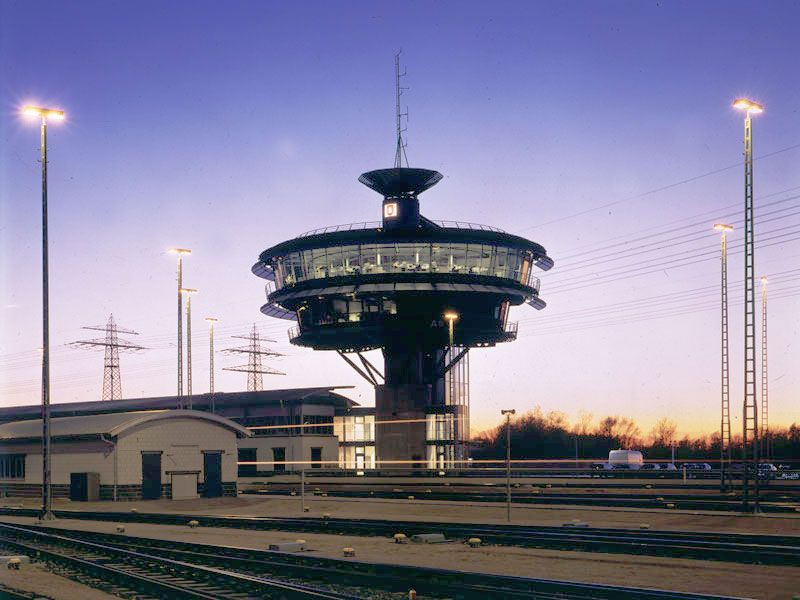Innovative Architektur seit 1970
Hafenbahnhof – Hamburg Waltershof





Hafenbahnhof
Die Trasse der Bundesautobahn A7 mit der Silhouette des Altenwerder Kirchturms bildet den optischen Bezug zum Betriebsgelände des neuen Hafenbahnhofs. Städtebaulich folgt das Konzept den vorhandenen Strukturen von Gleiskörper und Naturraum. Gemeinsam mit dem Altenwerder Kirchturm entsteht ein „Stadttor“ zur Freien und Hansestadt Hamburg.
Die besondere Lage des Projektgebiets am Rande des Naturschutzparks „Alte Süderelbe“ und des Hafenerweiterungsgebiets Altenwerder stellt besondere Anforderungen an die architektonische Gestaltung, städtebauliche und landschaftsplanerische Einbindung des Bauvorhabens. Das Entwurfskonzept basiert auf der Verbindung zwischen Architektur und Freiraum in Form linearer Strukturen, die den Raum strahlenförmig von SW nach NO öffnen.
Das Gebäude beherbergt neben Bergmeister und Leitzentrale im Tower, auch Räumlichkeiten für Personal und Wartung im länglichen Betriebsgebäude. In der Nähe des Ablaufbergs errichtet, haben Bergmeister, Fahrdienstleiter und die Beschäftigten in der Dispositionszentrale einen uneingeschränkten Überblick über den Ablaufberg. Da die Sicht durch die Gleisfeldbeleuchtung nicht beeinträchtigt werden darf wurde die Höhenlage der Tower-Räume mit 15 m über Terrain festgelegt.
Das nicht unterkellerte Betriebsgebäude wird im EG in Massivbauweise mit tragenden Außen- und Innenmauerwerk, Stahlbetonsohle und –decke errichtet. Das Außenmauerwerk ist mit Betonsteinen als hinterlüftete Fassade ausgeführt. Auf dem konstruktiv zum EG gehörigen Brüstungsmauerwerk des Obergeschosses tragen sich zwei voneinander getrennte Stahlkonstruktionen ab.
Der Schaft des Towers leitet seine Kräfte in die Sohle des KG ab, die auf Bohrpfählen ruht. Dieser Schaft, der gleichzeitig den Versorgungsschacht für die Obergeschosse bildet, verjüngt sich in ca. 9,9 m über Terrain und wird mit kleinerem Durchmesser bis über das Terrassendach geführt. Auf der Ebene der Verjüngung führt eine außenliegende Stahlkonstruktion (F30) die Lasten der auskragenden Geschosse in den Towerschaft zurück. Diese als Dreiecksverband ausgebildete Konstruktion ist mit einer Stahlbetondecke zu den Nutzgeschossen abgeschottet und nimmt die F90-verkleidete Stahlkonstruktion der Nutzebenen auf. Als Zugelement wird auch der Aufzugskern (Stahlbeton) mit den auskragenden Treppenläufen statisch mit herangezogen. Die oberen Geschosse stellen jeweils eigene Brandabschnitte dar. Fußböden als Hohlraumböden und Decken als System-Akustikdecken ermöglichen eine flexible Nachinstallation. Die Fassade der Obergeschosse des Towers wird als vorgehängte, thermisch getrennte Alu-Pfosten-Riegel-Konstruktion, mit Phon-Stop und Sonnenschutzverglasung (innen entspiegelt) ausgeführt. Um die Fassaden laufen Rettungsbalkone mit eingehängtem starren Sonnenschutz aus Alu-Lochblech.
Project Description
Harbor Railroad Station
The alignment of the A7 Motorway with the old steeple of Altenwerder’s church tower forms the optical reference to the works and rail-yards of the new Harbor Station. The urban planning-concept accords with the existing rail-structures and the natural surrounds. Together with the church tower, a kind of gateway is formed to the Free and Hanseatic City of Hamburg. The special location of the project area at the edge of the Alte Süderelbe protected nature-reserve and the Altenwerder harbor widening- scheme affords a special challenge for the architectonics, the planned integration of both urban and rural elements. The design concept is based on the interplay between architecture and free space in the form of linear radial structures that open up the area from the south west round to the north east, creating a transition from industrial area to open country. The long utility building parallel to the railway tracks and the tower building rising high above it mark the architectonic transformation of the urban situation at this place.
On the border between the open country and the industrial area at the edge of the Elbe mud-flats, the architecture has to mediate between the opposing landscapes of industry and nature.
The building consists of two parts. A two-story utility unit accommodating workshops, rooms for material deposit areas plus changing- and locker-rooms for the track-maintenance workers on the ground floor, and offices for administration and customs on the first floor. The tower building, also equipped with two functional floors, starts at the height of 15 m. It comprises the operational area of the incline controller, who is in charge of the down-rolling wagons, shunting them onto the right tracks and connecting them to long freight trains. He has to oversee an angle of almost 180°, from the downhill ramp to a track field consisting of about 20 rails. Also included is a large server-room where the computers are housed and operated.
The level above the incline operator contains the planning and disposition management department. Here all containers are registered that are unloaded off the big sea ships in the southern part of the Port of Hamburg. These containers have to be assembled and arranged into long freight trains bound for destination all over Germany.
The 2-storey utility building has no basement and is massively built with supporting brick walls and reinforced concrete slabs. The outer brickwork consists of a white Dutch concrete brick. The roof is a steel framework construction with an axis center-distance of 6.6 meters, covered with aluminum sheeting. The façade is built as a pillar and bar construction and is also made of aluminum.
The tower building consists of two different constructions. A reinforced concrete tube carries the two-story steel construction of the glass tower. The additional concrete shaft of the elevator acts as a reinforcing element which stabilizes the tower. The façade of the tower also consists of aluminum and is fitted with special non-glare glass panes so that a permanent sun-blind of aluminum sheeting guarantees an optimum view across the tracks.
Hafenbahnhof
„Alte Süderelbe“, Hamburg Waltershof
Wettbewerb 1991 – 1. Preis
Fertigstellung 1995
BGF 4.200 qm
Harbor Railroad Station
„Alte Süderelbe“, Hamburg Waltershof
Competition 1991 – 1st prize
Completion 1995
BGF 4.200 qm

Hafenbahnhof
„Alte Süderelbe“, Hamburg Waltershof
Wettbewerb 1991 – 1. Preis
Fertigstellung 1995
BGF 4.200 qm
Harbor Railroad Station
„Alte Süderelbe“, Hamburg Waltershof
Competition 1991 – 1st prize
Completion 1995
BGF 4.200 qm




Projektbeschreibung
Hafenbahnhof
Die Trasse der Bundesautobahn A7 mit der Silhouette des Altenwerder Kirchturms bildet den optischen Bezug zum Betriebsgelände des neuen Hafenbahnhofs. Städtebaulich folgt das Konzept den vorhandenen Strukturen von Gleiskörper und Naturraum. Gemeinsam mit dem Altenwerder Kirchturm entsteht ein „Stadttor“ zur Freien und Hansestadt Hamburg.
Die besondere Lage des Projektgebiets am Rande des Naturschutzparks „Alte Süderelbe“ und des Hafenerweiterungsgebiets Altenwerder stellt besondere Anforderungen an die architektonische Gestaltung, städtebauliche und landschaftsplanerische Einbindung des Bauvorhabens. Das Entwurfskonzept basiert auf der Verbindung zwischen Architektur und Freiraum in Form linearer Strukturen, die den Raum strahlenförmig von SW nach NO öffnen.
Das Gebäude beherbergt neben Bergmeister und Leitzentrale im Tower, auch Räumlichkeiten für Personal und Wartung im länglichen Betriebsgebäude. In der Nähe des Ablaufbergs errichtet, haben Bergmeister, Fahrdienstleiter und die Beschäftigten in der Dispositionszentrale einen uneingeschränkten Überblick über den Ablaufberg. Da die Sicht durch die Gleisfeldbeleuchtung nicht beeinträchtigt werden darf wurde die Höhenlage der Tower-Räume mit 15 m über Terrain festgelegt.
Das nicht unterkellerte Betriebsgebäude wird im EG in Massivbauweise mit tragenden Außen- und Innenmauerwerk, Stahlbetonsohle und –decke errichtet. Das Außenmauerwerk ist mit Betonsteinen als hinterlüftete Fassade ausgeführt. Auf dem konstruktiv zum EG gehörigen Brüstungsmauerwerk des Obergeschosses tragen sich zwei voneinander getrennte Stahlkonstruktionen ab.
Der Schaft des Towers leitet seine Kräfte in die Sohle des KG ab, die auf Bohrpfählen ruht. Dieser Schaft, der gleichzeitig den Versorgungsschacht für die Obergeschosse bildet, verjüngt sich in ca. 9,9 m über Terrain und wird mit kleinerem Durchmesser bis über das Terrassendach geführt. Auf der Ebene der Verjüngung führt eine außenliegende Stahlkonstruktion (F30) die Lasten der auskragenden Geschosse in den Towerschaft zurück. Diese als Dreiecksverband ausgebildete Konstruktion ist mit einer Stahlbetondecke zu den Nutzgeschossen abgeschottet und nimmt die F90-verkleidete Stahlkonstruktion der Nutzebenen auf. Als Zugelement wird auch der Aufzugskern (Stahlbeton) mit den auskragenden Treppenläufen statisch mit herangezogen. Die oberen Geschosse stellen jeweils eigene Brandabschnitte dar. Fußböden als Hohlraumböden und Decken als System-Akustikdecken ermöglichen eine flexible Nachinstallation. Die Fassade der Obergeschosse des Towers wird als vorgehängte, thermisch getrennte Alu-Pfosten-Riegel-Konstruktion, mit Phon-Stop und Sonnenschutzverglasung (innen entspiegelt) ausgeführt. Um die Fassaden laufen Rettungsbalkone mit eingehängtem starren Sonnenschutz aus Alu-Lochblech.
Project Description
Harbor Railroad Station
The alignment of the A7 Motorway with the old steeple of Altenwerder’s church tower forms the optical reference to the works and rail-yards of the new Harbor Station. The urban planning-concept accords with the existing rail-structures and the natural surrounds. Together with the church tower, a kind of gateway is formed to the Free and Hanseatic City of Hamburg. The special location of the project area at the edge of the Alte Süderelbe protected nature-reserve and the Altenwerder harbor widening- scheme affords a special challenge for the architectonics, the planned integration of both urban and rural elements. The design concept is based on the interplay between architecture and free space in the form of linear radial structures that open up the area from the south west round to the north east, creating a transition from industrial area to open country. The long utility building parallel to the railway tracks and the tower building rising high above it mark the architectonic transformation of the urban situation at this place.
On the border between the open country and the industrial area at the edge of the Elbe mud-flats, the architecture has to mediate between the opposing landscapes of industry and nature.
The building consists of two parts. A two-story utility unit accommodating workshops, rooms for material deposit areas plus changing- and locker-rooms for the track-maintenance workers on the ground floor, and offices for administration and customs on the first floor. The tower building, also equipped with two functional floors, starts at the height of 15 m. It comprises the operational area of the incline controller, who is in charge of the down-rolling wagons, shunting them onto the right tracks and connecting them to long freight trains. He has to oversee an angle of almost 180°, from the downhill ramp to a track field consisting of about 20 rails. Also included is a large server-room where the computers are housed and operated.
The level above the incline operator contains the planning and disposition management department. Here all containers are registered that are unloaded off the big sea ships in the southern part of the Port of Hamburg. These containers have to be assembled and arranged into long freight trains bound for destination all over Germany.
The 2-storey utility building has no basement and is massively built with supporting brick walls and reinforced concrete slabs. The outer brickwork consists of a white Dutch concrete brick. The roof is a steel framework construction with an axis center-distance of 6.6 meters, covered with aluminum sheeting. The façade is built as a pillar and bar construction and is also made of aluminum.
The tower building consists of two different constructions. A reinforced concrete tube carries the two-story steel construction of the glass tower. The additional concrete shaft of the elevator acts as a reinforcing element which stabilizes the tower. The façade of the tower also consists of aluminum and is fitted with special non-glare glass panes so that a permanent sun-blind of aluminum sheeting guarantees an optimum view across the tracks.

